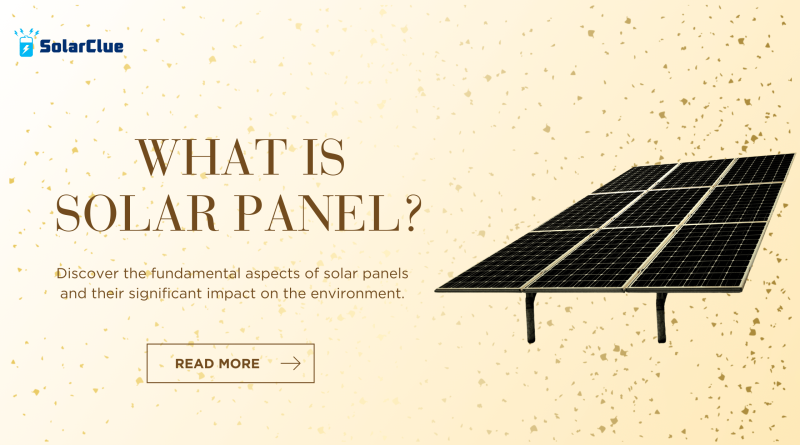What Is Solar Panel?
Solar panels are becoming increasingly popular as a sustainable energy solution. They offer a way to harness the power of the sun and convert it into usable electricity. This blog will explain what solar panels are, how they work, their basic components, different types, and their common applications.
Table of Contents
What is a Solar Panel?
A solar panel, also known as a photovoltaic (PV) panel, is a device that converts sunlight into electricity. The primary function of a solar panel is to capture sunlight and transform it into electrical energy that can be used to power homes, businesses, and various electronic devices.
How Do Solar Panels Work?
The Photovoltaic Effect
The key principle behind solar panels is the photovoltaic effect. When sunlight, composed of photons, strikes the surface of a solar panel, it excites electrons in the semiconductor material, typically silicon, within the solar cells. This excitement causes electrons to break free from their atoms, creating an electric current.
Basic Components of a Solar Panel
Solar Cells
Solar cells are the fundamental units of a solar panel. Each cell consists of layers of silicon that create an electric field. When sunlight hits the cells, it knocks electrons loose, generating a flow of electricity.
Glass Layer
The glass layer covers the solar cells to protect them from environmental damage, such as dirt, water, and physical impact, while allowing sunlight to pass through.
Frame
The frame, usually made of aluminum, provides structural support and protects the edges of the panel. It also facilitates mounting the panel on rooftops or other structures.
Junction Box
The junction box is attached to the back of the solar panel and houses the electrical connections and diodes. It acts as the interface between the panel and the external wiring system, ensuring safe and efficient operation.
Encapsulant and Backsheet
These layers protect the solar cells from moisture, dirt, and mechanical damage. The encapsulant is a transparent layer that holds the solar cells together, while the backsheet provides insulation and protection from the back.
Types of Solar Panels
| Type of Solar Panel | Description | Common Applications |
|---|---|---|
| Monocrystalline | Made from single-crystal silicon, offering high efficiency and durability. | Residential, commercial, and industrial installations |
| Polycrystalline | Made from multiple silicon crystals, slightly less efficient but more cost-effective. | Residential and commercial installations |
| Thin-Film | Made from materials like cadmium telluride or amorphous silicon, flexible and lightweight. | Portable devices, building-integrated photovoltaics |
| Bifacial | Can capture sunlight from both sides, increasing overall energy production. | Ground-mounted systems, commercial installations |
| Concentrated PV (CPV) | Uses lenses or mirrors to concentrate sunlight onto high-efficiency cells. | Utility-scale power plants |
How Do These Components Work Together?
1. Sunlight Hits the Solar Cells: Photons from the sun strike the surface of the solar cells.
2. Electric Field Creates Current: The electric field in the cells causes electrons to move, generating a direct current (DC).
3. Junction Box Distributes Power: The junction box routes the DC electricity to an inverter.
4. Inverter Converts DC to AC: The inverter converts the DC electricity into alternating current (AC), which can be used by standard electrical devices and fed into the power grid.
5. Electricity Powers Devices: The generated electricity powers homes, businesses, or is stored in batteries for later use.
Common Applications of Solar Panels
1. Residential Use: Powering homes, reducing electricity bills, and increasing energy independence.
2. Commercial Use: Reducing operational costs and improving sustainability for businesses.
3. Industrial Use: Providing a reliable power source for manufacturing and large-scale operations.
4. Portable Devices: Powering small electronics, such as solar chargers and portable lights.
5. Utility-Scale Power Plants: Generating large amounts of electricity to supply the power grid.
Conclusion
Solar panels are an essential technology for harnessing renewable energy from the sun. Understanding their components, types, and how they work together helps in making informed decisions about their use and benefits. As solar technology continues to advance, it promises to play a significant role in the global shift towards sustainable energy.
Here at SolarClue®, we offer a smart, practical, and “beautiful” solution. You will be answered for all the questions related to Solar.
We provide all kinds of brands that are the Best Solar panels in India.
If you are the one who is planning for the solar power system. Don’t hesitate to contact our team!
Looking forward to empowering you with solar energy, just like hundreds of our other clients!
FAQs
1. What is the lifespan of a solar panel?
Solar panels typically have a lifespan of 25-30 years, with many maintaining high efficiency beyond this period.
2. Can solar panels generate electricity on cloudy days?
Yes, solar panels can still generate electricity on cloudy days, though they operate less efficiently compared to sunny conditions.
3. Do solar panels require a lot of maintenance?
Solar panels require minimal maintenance, usually just periodic cleaning to remove dust, dirt, and debris.
4. How do I choose the right type of solar panel for my needs?
Consider factors such as efficiency, cost, space availability, and specific energy requirements when choosing the right type of solar panel.
5. Are there incentives for installing solar panels?
Many governments offer incentives, such as tax credits and rebates, to encourage the adoption of solar energy. Check with local authorities for available programs.




